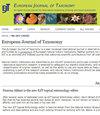黑暗中的生活:洞穴适应的菊科动物(六足目,双足目)
IF 1.1
3区 生物学
Q3 ENTOMOLOGY
引用次数: 0
摘要
尽管它们是重要的大型捕食者,但在洞穴生态系统中发现的贾蝇科(Diplura)物种很少。这个六足动物群体的一小部分稀有标本的收集,使我们得以探索新西兰、摩洛哥和南非洞穴中japygids的分类,并描述了一个新属:Imazighenjapyx Sendra &Sánchez-García gen. nov.,以及四个新种:Austrjapyx wynbergensis Sendra &Sánchez-García sp. nov., Imazighenjapyx marocanus Sendra &Sánchez-García gen. et sp. nov., Opisthjapyx naledi Sendra &Sánchez-García sp. 11 . and Teljapyx aotearoa Sendra &对于每一个新的分类群,我们都对它们的栖息地进行了全面的描述。这些新发现导致了对分布的修订,并允许重新评估世界上已知的15种穴居菊科植物的形态特征。本文讨论了瓢虫腹螯的功能形态及其对捕食的适应性,以及它们在交配行为中的潜在作用。本文章由计算机程序翻译,如有差异,请以英文原文为准。
Life in darkness: an overview of cave-adapted japygids (Hexapoda, Diplura)
Few species of Japygidae (Diplura) have been discovered in cave ecosystems despite their importance as large predators. A small collection of rare specimens of this hexapod group has allowed to explore the taxonomy of japygids from caves in New Zealand, Morocco and South Africa, and to describe one new genus: Imazighenjapyx Sendra & Sánchez-García gen. nov., as well as four new species: Austrjapyx wynbergensis Sendra & Sánchez-García sp. nov., Imazighenjapyx marocanus Sendra & Sánchez-García gen. et sp. nov., Opisthjapyx naledi Sendra & Sánchez-García sp. nov. and Teljapyx aotearoa Sendra & Sánchez-García sp. nov. For each of the new taxa we give a comprehensive description of their habitats. These new findings resulted in a revision of the distribution and allowed to re-evaluate the morphological traits of the fifteen cave-adapted japygids species already known worldwide. The functional morphology of the remarkable abdominal pincers of Japygidae and their adaptation to predation are discussed, as well as their potential role in mating behaviour.
求助全文
通过发布文献求助,成功后即可免费获取论文全文。
去求助
来源期刊

European journal of taxonomy
ZOOLOGY-
CiteScore
2.30
自引率
8.30%
发文量
173
审稿时长
29 weeks
期刊介绍:
EJT is a fully refereed, international, fully electronic Open Access journal in descriptive taxonomy, covering subjects in zoology, entomology, botany (in its broadest sense), and palaeontology. EJT-papers must be original and adhere to high scientific (content) and technical (language, artwork, etc.) standards. Manuscripts that are clearly substandard in either of these categories will not be sent out for review. EJT is supported by a consortium of European Natural History Institutes, but its scope is global. Both authorship and geographical region of study need not be European. Authors are, however, strongly encouraged to involve European Natural History collections by consulting material or by depositing specimens (e.g. types and figured material) related to their published paper in the collection of a European Natural History Institute.
 求助内容:
求助内容: 应助结果提醒方式:
应助结果提醒方式:


